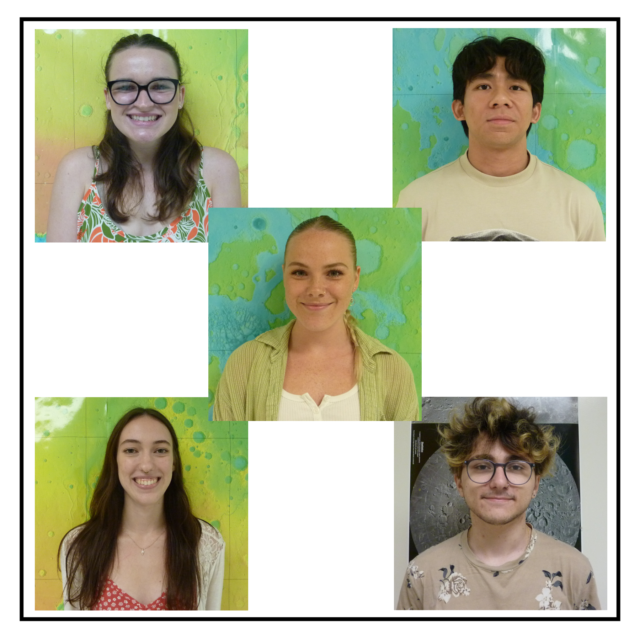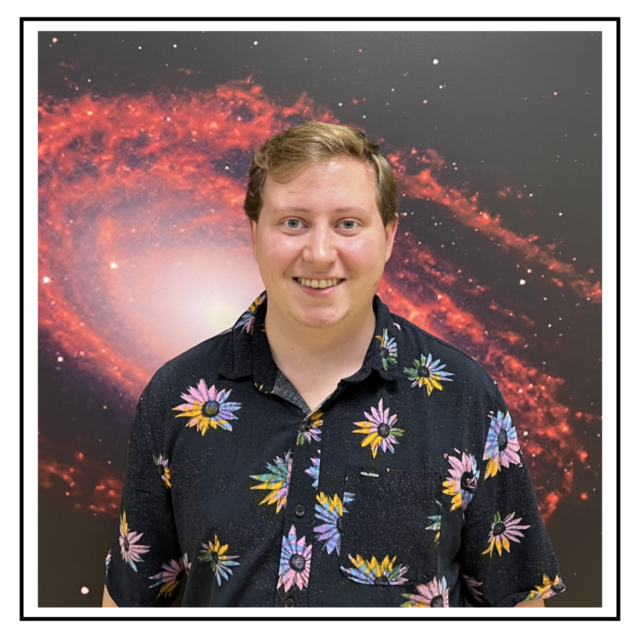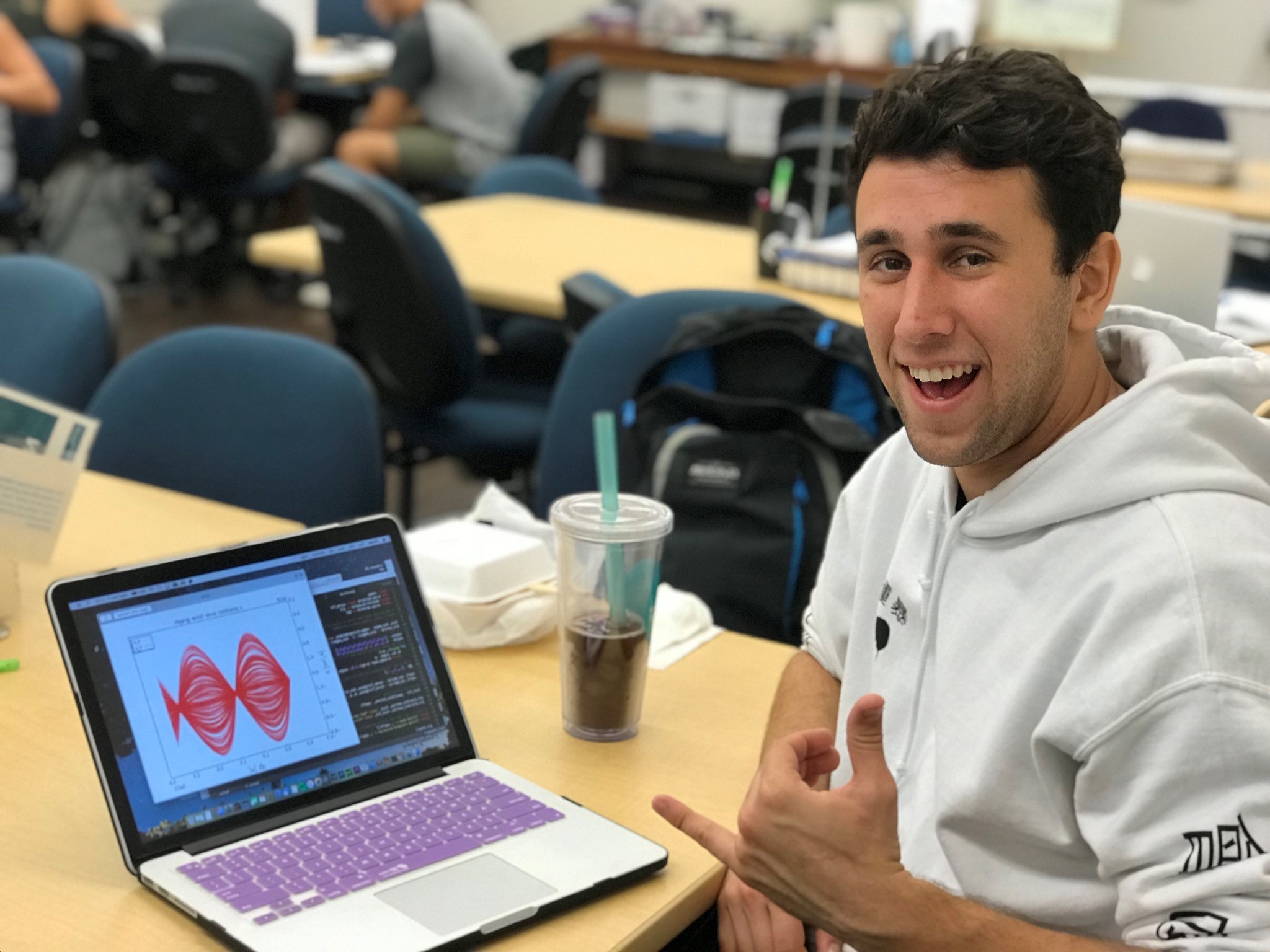
The Hawai‘i Space Grant Consortium expands educational opportunities for University of Hawai‘i System undergraduates by awarding University Research Internships, HSGC URI, (formerly known as Fellowship and Traineeship Program) in fields that are relevant to NASA's goals. Two levels of support, research or trainee, are offered depending on the skill, knowledge level, and time commitment of the student. We support the national Space Grant agenda to help prepare the future generation of space scientists and engineers, and to increase the understanding and development of space. U.S. citizenship is required for consideration.
Fields relevant to NASA's goals are defined in its current Strategic Plan. These fields are mainly those in science, technology, and education that are focused on understanding the Earth, exploring the Solar System and the universe beyond, creating more secure, efficient, and environmentally friendly air transportation systems, inspiring students to pursue careers in science, technology, engineering, and mathematics, and engaging the public in shaping and sharing the experience of exploration and discovery.
HSGC University Research Internship students work under the guidance of mentors who are usually faculty members. Women, under-represented minorities (specifically Hawaiians, other Pacific Islanders, Native Americans, African Americans, and Hispanics), and physically challenged students who have interest in space-related fields are particularly encouraged to apply.

HSGC URI Research Internship
All full-time undergraduates enrolled at the University of Hawai‘i at Mānoa, Hilo, Maui College, one of the University of Hawai‘i Community Colleges, and University of Guam who have declared a major are eligible to apply for HSGC URI Research Internships. Applicants must be U.S. citizens and must be sponsored by a mentor who is willing to guide the student for the duration of the award. Most mentors are faculty at the University but senior researchers or other qualified personnel at UH or elsewhere are eligible. HSGC URI Research Internship students are expected to work between 10 and 15 hours a week during the semester depending on their project. Financial support includes a one-semester stipend of $5000, renewable for a second semester for a total of $10000 per academic year. A travel and supply budget of $1000 per semester will be available.
HSGC URI Trainee Internship
All full-time undergraduates enrolled at the University of Hawai‘i at Mānoa, Hilo, Maui College, one of the University of Hawai‘i Community Colleges, and University of Guam are eligible to apply for HSGC URI Trainee Internships. Applicants must be U.S. citizens and must be sponsored by a mentor who is willing to guide the student for the duration of the award. HSGC URI Trainee Internship students are expected to work between 5 and 10 hours a week during the semester depending on their project. Financial support includes a one-semester stipend of $2500, renewable for a second semester for a total of $5000 per academic year. Or a one-semester Trainee Internship at $2500 can be extended into a second semester Research Internship at $5000 for a total award of $7500 per academic year. A supply budget of $500 per semester is available for Trainee Internships.
HSGC URI Group Research Internship
All full-time undergraduates enrolled at the University of Hawai‘i at Mānoa, Hilo, Maui College, one of the University of Hawai‘i Community Colleges, and the University of Guam are eligible to apply for HSGC URI Group Research Internships. Applicants must be U.S. citizens and must be sponsored by a mentor who is willing to guide the students for the duration of the award. HSGC URI Group Research Internship students are expected to work between 5 and 10 hours a week during the semester depending on their project. Financial support includes a one-semester stipend of $2500, renewable for a second semester for a total of $5000 per academic year for each student in the group. A travel and supply budget of $500 per semester is available for each student in the group.

Spring 2024 HSGC URI "UH Manoa" Research Interns
-
Jackson RichardsUniversity of Hawaiʻi at Mānoa

-
Julia WilliamsUniversity of Hawaiʻi at Mānoa

-
Oliver SuncinUniversity of Hawaiʻi at Mānoa


Jackson Richards
Project Title: “Investigation of Spectral Wave Model Forecast Near Hawai`i Using Satellites”
Mentor: Dr. Justin Stopa, Assistant Professor, ORE – UHM
Jackson Richards is a Junior majoring in Global Environment Science. His project is based off the “Investigation of Spectral Wave Model Forecast Near Hawai`i Using Satellites.” Ocean waves are a key component of Earth’s complex climate system, contributing to ocean circulation patterns that shape our coasts as we know of today. Now more than ever, there is a growing need for reliable wave forecasts in our rapidly changing world. Wave models are important tools that help us predict ocean conditions in advance. Although wave models can predict ocean conditions accurately at the beginning of a forecast, their performance typically degrades as a function of forecast time. Considering the importance of wave model performance, this proposed research project will rigorously evaluate a spectral wave model in Hawaiʻi using buoy and satellite observations as reference. This will be done by obtaining buoy, model, and satellite datasets, investigating these matchups relative to ocean conditions, and applying various error metrics to analyze the model.

Julia Williams
Project Title: “Mineral Distribution in Three Particles from Asteroid Ryugu”
Mentor: Dr. Elena Dobrica, Professor, HIGP – UHM
Julia Williams is a Junior majoring in Astrophysics. Her research project on “Mineral Distribution in Three Particles from Asteroid Ryugu” project aims to identify and evaluate the distribution of aqueous alteration minerals within the Ryugu samples. The proposed research project will focus on the presence of chemical heterogeneities that could help us decipher the growth conditions and mechanisms that could have modified these minerals. The results will have important implications that will enhance our understanding of the local geochemical microenvironments within the Ryugu asteroid.

Oliver Suncin
Project Title: “Reaction Wheels Derived from Hard Disk Drives for use in Cube Satellites”
Mentor: Dr. Amber-Imai Hong, Staff, HIGP – UHM
Oliver Suncin is a Junior majoring in Mechanical Engineering with an Aerospace Concentration. His research “Reaction Wheels Derived from Hard Disk Drives for use in Cube Satellites” is an approach to utilizing Hard Disk Drive (HDD) components as a low-cost alternative for reaction wheels in CubeSats during the duration of the Spring 2024 term. As small satellites gain popularity for low-cost space missions, the restrictive expense of attitude determination and control sensing systems that include traditional reaction wheels currently available on the market poses a challenge. This project aims to demonstrate the performance and viability of HDD platters and spindles as functional reaction wheels. It emphasizes on risk mitigation, cost reduction, and technological advancement, the project aspires to resolve financial constraints in CubeSat missions.
Spring 2024 HSGC URI Group "UH Manoa" Research Interns
-
CREPESUniversity of Hawaiʻi at Mānoa

-
Frames GroupUniversity of Hawaiʻi at Mānoa

-
GNESESUniversity of Hawaiʻi at Mānoa

-
VIA-SEEsUniversity of Hawaiʻi at Mānoa


CREPES
Group Members:
Sapphira Akins – Junior, Mechanical Engineering w/ Aerospace Concentration
Howin Ma – Junior, Mechanical Engineering w/ Aerospace Concentration
Christopher Freitas – Senior, Mechanical Engineering
John Ryan Taylor – Senior, Electrical Engineering
Ian Ogata – Junior, Mechanical Engineering
Mentor: Dr. Peter Englert, Professor, HIGP – UHM
The “CubeSat Relativistic Electron and Proton Energy Separator” mission, also known as CREPES, is a student-driven project derived from the University of Hawaiʻi at Mānoa’s Earth and Planetary Exploration Technology (EPET) course that aims to utilize a 1U CubeSat carrying a set of silicon and gas electron multiplier (GEM) detectors to collect Solar Energetic Particle data. With this Solar Energetic Particle (SEP) data, the team can locate flux and energy density of the solar ejecta to better understand solar modulation and its role in accelerating and transporting solar energetic particles.

Frames Group
Group Members
Taylor Todd – Sophomore, Mechanical Engineer
Micah Chang – Senior, Mechanical Engineer
Mentor: Dr. Joseph Brown, Professor – UHM
Advanced Interlocking Structural Frames for Rapid Construction and Assembly is an approach to joining tubing without traditional fasteners. These frames allow quick connections, retaining and releasing components as needed. The project’s primary goal is to aid NASA’s strategic objectives, particularly in human space exploration4. Whether in low earth orbit, on the moon, or on distant planets, interlocking frames offer astronauts a faster, easier way to assemble structures. Beyond NASA, these frames could also find applications in terrestrial infrastructure development and other space grant projects.

GNESES
Project Title: Gamma Neutron Energy Space Exploration Spectrometer (GNESES)
Savannah Dubois – Junior, Mechanical Engineering with Aerospace Concentration
Duy Lee – Junior, Mechanical Engineering with Aerospace Concentration
Gianna Longo – Junior, Astronomy
Kate Macaulay – Sophomore, Mechanical Engineering with Aerospace Concentration
Alexander Peterson – Sophomore, Mechanical Engineering
Mentor: Dr. Peter Englert, Professor, HIGP – UHM
“Gamma Neutron Energy Space Exploration Spectrometer (GNESES)” is an innovative proposal that integrates neutron and gamma-ray detection for planetary exploration in a small volume array. Crafted in alignment with the NASA 2023-2032 decadal survey objectives, GNESES is designed to address critical goals such as determining planetary elemental composition, identifying water, and ultimately assessing the habitability potential of Mars and the Moon.

VIA-SEEs
Group Members
Ralph Martin Adra – Junior, Astrophysics
Jennai Dreger – Senior, Environmental Earth Science
Katalyna Larvarez – Junior, Astrophysics
Nikola Mazzarella – Junior, Physics
Dalten Morales-Pang – Junior, Mechanical Engineering with Aerospace Concentration
Mentor: Dr. Peter Englert, Professor, HIGP – UHM
The “Variability in Atmosphere due to Solar Energetic Events Study” (VIA-SEEs) is a CubeSat mission that intends to act as a joint science and technology mission. The continuing project is student-led under the support of the Earth and Planetary Exploration Technologies (EPET) program at the University of Hawaiʻi at Mānoa. The VIA detector development activities include the development of a spectrometer testbed, generating spectral reference data, and preparing scientific data acquisition from Low Earth Orbit. The team is able to study Solar Energetic Electrons, Nitrous Oxide, and Ozone concentration concurrently and after a solar event in order to study the degradation effects on our atmosphere.
Spring 2024 HSGC URI "UH Manoa" Trainees

Noah Thompson
Project Title: Exploring On-Board Computers with Multi-Level Efficiency for CubeSats
Mentor: Dr. Amber-Imai Hong, Staff, HIGP – UHM
Noah Thompson is a Senior studying Mechanical Engineering with an Aerospace Concentration. His research entitled “Exploring On-Board Computers with Multi-Level Efficiency for CubeSats” aims to investigate different On-Board Computers (OBC), emphasizing features that make them best suited for various CubeSat projects. Considering robustness, efficiency, and cost, the study aims to assist in OBC selection for current and future projects making them more efficient and achievable. This research can support cost-effective solutions and make CubeSat projects more achievable and efficient.
Spring 2024 HSGC URI "UH Hilo" Research Interns
-
Angela ClaibournUniversity of Hawaiʻi at Hilo

-
Atlas Syncatto (aka Jessica Quarles)University of Hawaiʻi at Hilo

-
Edward WardUniversity of Hawaiʻi at Hilo


Angela Claibourn
Project King: “Uncovering Properties of Planet-Hosting Stars Across the Milky Way Galaxy”
Mentor: Dr. Winston Wu, Assistant Professor, Computer Science – UHH
Angela Claibourn is a Sophomore majoring in Astronomy and Physics. Her research is on “Uncovering Properties of Planet-Hosting Stars Across the Milky Way Galaxy” which is focused on the question: ʻAre planet formation still suppressed around close binary stars and metal-poor stars throughout our galaxy?ʻ The project is to answer this research question in a multi-faceted big data project that will expand our knowledge of stars and the conditions for exoplanet formation. It has three concrete research thrusts: crossmatching and analysis of two large star catalogs, machine learning to predict stellar properties, and the development of a web interface to share research findings.

Atlas Syncatto (aka Jessica Quarles)
Project Title: Determining the Structure and Mass Distribution of the Laniakea Supercluster using Type Ia Supernovae
Mentor: Dr. David Jones, Faculty, Institute for Astronomy – UHH
Atlas Syncatto is a Sophmore majoring in Astronomy & Philosophy and minoring at Physics. Her research proposal discusses the topic on “Determining the Structure and Mass Distribution of the Laniakea Supercluster using Type Ia Supernovae.” The project is to derive an understanding of the structure and mass distribution of the Laniakea Supercluster which will give us insight into other large structures throughout the universe. It may also tell us more about the Lambda Cold Dark Matter model, including how dark energy and cold dark matter influence baryonic matter and form structures like Laniakea.

Edward Ward
Project Title: “A New Analysis of Abundances and Diffuse Ionized Gas in M33”
Mentor: Dr. Rene-Pierre Martin, Professor, Institute for Astronomy – UHH
Edward Ward is a Senior majoring in Astronomy and minoring in Physics. His project entitled “A New Analysis of Abundances and Diffuse Ionized Gas in M33” examines the influence of diffuse ionized gas (DIG) on measurements of star formation and nebular abundances in the nearby spiral galaxy M33. Gradients are derived from measurements of individual nebular regions within a galaxy. Since the slope of radial abundance gradients across galaxy disks can tell us details about a galaxy’s history, understanding the potential influence of DIG on measurements of these gradients could have significant implications for the study of galaxies in general.
Spring 2024 HSGC URI Group "UH Hilo" Research Interns

Galaxy – Joint project
Group Members
Mekhi Woods – Junior, Astronomy & Physics
Augustus Coffey – Senior, Astronomy & Physics
Dr. Marianne Takamiya, Professor, Institute for Astronomy – UHH
Their joint project Galaxy Morphology and Evolution Pertaining to Asymmetry & Investigating the Correlation Between Galaxy Age Petrosian Radius via JWST Observations. Aligns with NASA’s goal of expanding humanity’s knowledge about our universe. By using data from the James Webb Space Telescope(JWST), we will observe and intend to understand the early structure of galaxies. Our main research question is: “How did the first galaxies form, [and] how did we end up with the large variety of galaxies we see today?” By analyzing the structure of these early galaxies and comparing them to newer galaxies, we intend to show how galaxy formation has changed throughout our Universe’s history.
Spring 2024 HSGC URI "Honolulu CC" Trainees

First Nations Launch
Members:
Christian Falcon – Junior, Natural Science – Engineering Joe
Vincent Yuro – Sophomore, Electronic & Computer Engineering Technology
Reymart Galano – Freshman, Natural Science
Justin Lucas Yuro – Junior, Electronic & Computer Engineering Technology
Mentor: Dr. Jung Park
Honolulu Community College’s Team is competing in the First Nation’s Launch 2024 Moon Challenge. Our objective is to design, build, and test a rocket and payload lander within certain restraints. The payload lander contains a GPS, camera, and altimeter with various functions and will be deployed from the rocket.
Spring 2024 HSGC URI "Maui CC" Trainees

CanSat Competition 2024
From left to right, Reymart Galano, Brandon Chung, Christian Falcon, Justin Lucas Bio, Joe Vincent Yuro.
The CanSat competition is an annual space-related competition open to university students worldwide. It provides students with design-build-launch engineering experience in real-world systems such as telemetry collection, communication, and autonomous systems. Team Kūkulu Ukali is in the competition’s critical design stage and on track to launch our payload at Virginia Tech in June 2024.
Spring 2024 HSGC URI "Kapi'olani CC" Trainees
-
Akira AllenKapi'olani Community College

-
Alexander ShultisKapi'olani Community College

-
Mason JoynerKapi'olani Community College


Akira Allen
Project Title: Testing of Gravitation Action by Small Satellite Experiment
Major: Mechanical Engineering
Mentor: Dr. Radovan Milincic

Alexander Shultis
Alexander Shultis is an undergraduate student majoring in Astrophysics. His proposed title Zero Gravity Galileo Drop using a mini satellite in geostationary orbit he plans to measure the gravitational constant grav
Mentor: Dr. Radovan Milincic

Mason Joyner
Project Title: Zero Gravity (Ze-Ga) Galileo Drop
Major: Astrophysics
Mentor: Dr. Radovan Milincic
Spring 2024 HSGC URI "Windward CC" Trainees

100K Rocket Project & Windward Autonomous Robotic Project – 17 (Prime)
Members:
Christopher Klapperich – Computing, Security & Networking Technology
Clarence Weatherwax – Sophomore, Undeclared
Gavin Jones – Sophomore, Computer Engineering & minoring in Aerospace Option Program
Ryan Vanairsdale – Junior, Computer Engineering & minoring in Aerospace Option Program
Mentor: Dr. Jacob Hudson
100K Rocket Project
Continuing its efforts to expand experimental science to new heights, the WCC team is designing, testing, and building a two-stage rocket to reach altitudes of >100,000 feet carrying an unspecified payload. Reducing drag by constructing minimum diameter stages, as well as staging near transonic speeds is problematic, requiring an innovative approach to fusillage construction and sustainer stage initiation. Current progress on the development of this project will be presented.
Windward Autonomous Robotic Project – 17 (Prime)
ARLISS; A Rocket Launch for International Student Satellites, requires teams to design, test, and fly a scientific payload that will be deployed via rocket at ~10,000 ft, and then must autonomously make its way toward a designated target area, all the while accumulating atmospheric data. Current progress on the development of this year’s entry will be presented.
Spring 2024 NGSG "Guam" Interns
-
Ernie SameloUniversity of Guam

-
Gian ParasUniversity of Guam

-
Sierra AvellanaUniversity of Guam

-
UOG Drone CorpsUniversity of Guam


Ernie Samelo
Ernie Samelo is an undergraduate student majoring in Mathematics and minoring in History. He is doing a Teaching Internship where he teaches other students in his field of mathematics.
Mentor: Dr. Leslie Aquino
Credits:
NASA Guam Space Grant (NGSG) Instagram
Click here to view the Instagram Post

Gian Paras
Gian Paras is an undergraduate student majoring in Civil Engineering and minoring in Mathematics. He is doing a Teaching Internship where he teaches other students in his field of mathematics.
Credits:
NASA Guam Space Grant (NGSG) Instagram
@nasaguamspacegrant
Click here to view the Instagram Post

Sierra Avellana
Sierra Avellana is a Senior majoring in Business Administration. Her Professional Internship involves her gaining experience in marketing such as photography and videography.
Credits:
NASA Guam Space Grant (NGSG) Instagram
Click here to view the Instagram Post

UOG Drone Corps
Group Memebers:
Thomas Torres II (Top right)
Jared Camacho Diaz (Top left)
Julian Lign Abella (Bottom)
The UOG Drone Corps program is structured to be finished within a single academic year. The program encompasses three key components:
-
FAA Part 107 Examination Knowledge Course Completion: Participants engage in coursework related to the FAA Part 107 examination.
-
FAA Part 107 Certification: Successful completion of the certification process is a crucial milestone.
-
Accumulation of Flight Hours: This involves gaining practical experience through internships and missions.
Credits:
NASA Guam Space Grant (NGSG) Instagram
@nasaguamspacegrant
Thomas Torres II | Click here to view the Instagram Post
Jared Camacho Diaz | Click here to view the Instagram Post
Julian Lign Abella | Click here to view the Instagram Post

NASA funding of HSGC URI students requires U.S. citizenship. Applicants must complete a formal application, submit transcripts and a letter of support from the prospective mentor.
Use the application for your current campus you are enrolled at. The application forms, for HSGC URI Research or Trainee awards, are fillable PDFs to be completed digitally and printed. Signatures are required prior to submission.
Applications are also available from Space Grant offices at Mānoa (POST building room 501) or Hilo campuses, Maui College, and the Community College campuses. You may call the Mānoa office for more information at (808) 956-3138 or refer to the HSGC Personnel page, or email hsgc@spacegrant.hawaii.edu.
Undergraduate application deadlines: June 15 for fall semester and December 1 for spring semester.
HSGC URI Group, Research, and Trainee Applications
Important Forms for Current Students
Additional Information from NASA
-
Current NASA Strategic Plan (64-page .pdf document released in February, 2018.)
-
Listing of NASA and space-related resources
Additional Information from the University of Hawai'i

General Guidelines
Serving as a mentor for an undergraduate HSGC URI student is one of the most effective educational activities a researcher or faculty member can do. Mentoring a student in his or her research or trainee project can provide that extra spark that makes a dramatic difference in the life of a young person and in their approach to learning. The HSGC URI experience also enhances a student's education and shows how science and engineering are really done, much more than class and laboratory assignments can ever do.
To help prospective and existing mentors with this important job, the Hawai‘i Space Grant Consortium offers these guidelines:
Research Ohana
If you have a large research group, feel free to share mentoring responsibilities with graduate students and postdoctoral researchers. Much science is done by groups, so this adds to the research experience, as long as the undergraduate student has his or her own, identifiable project. It is also acceptable for a postdoc, research associate, or specialist to be a mentor. If a mentor has two or more HSGC URI students, be sure that each has an identifiable project, even if the projects are related. For example, one student could develop hardware, the other software on an engineering design project.
Space Connection
Space Grant is a NASA-funded project, and everything it does must have a clear connection to space science or aerospace engineering. Thus, mentors must be sure that their students remember to discuss the link with space science or aerospace engineering, especially when writing proposals and requests for extending projects, giving talks at our undergraduate symposium, and preparing their final reports.
Student's Time Commitment
Please remember that our HSGC URI students are undergraduates, not graduate students. They are full-time students, usually taking five courses. Consequently, they should not be expected to work more than about 15 hours per week. Sometimes a key challenge for a mentor is to be sure the undergraduate student does not neglect his or her other school work as they become engrossed in their research project!
Laboratory Duties
HSGC URI students are doing research or trainee projects. They are not student employees hired to clean the lab, run the copy machine, or do clerical work. Of course, everyone working in a laboratory is expected to do his or her share of laboratory maintenance, but we want to be sure that HSGC URI students are treated as researchers, not non-technical employees.
Important Forms for Prospective Mentors


Looking for Past Participant Information?
Information about our previous participants have been archived! Click the button below to view our entire listing of former undergraduate fellows, trainees, and interns.


Wonder what they are doing now? Click the button below to view their current occupation.
Forms
Required: LTS Tracking Form (fillable online)
NASA requires that we gather data on the education and employment history of current and former participants in our HSGC URI programs. Your help will enable us to improve our programs and assists us in seeking new funding to continue our operations to support student research and to conduct additional programs. The information that you provide here will be kept private and not shared with anyone except NASA, our sponsor.

Share Your Success Story!
Have a Story to Share?
If you are a past participant and have an interest in sharing how our Space Grant program has benefited you, we would love to hear from you. By doing so, you can help spread the word to others about how NASA's efforts in promoting education have made an impact on all our participants - like you! If interested, please click here to learn more. Contact us at hsgc@higp.hawaii.edu with a Subject Line of "Success Story."

Previous Final Reports
Final Reports written by Space Grant's participants (2005 - 2014) are available online for viewing on ScholarSpace. Click the button to view their work in booklets, released by year.